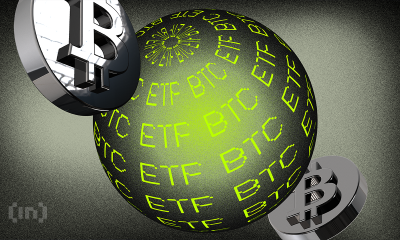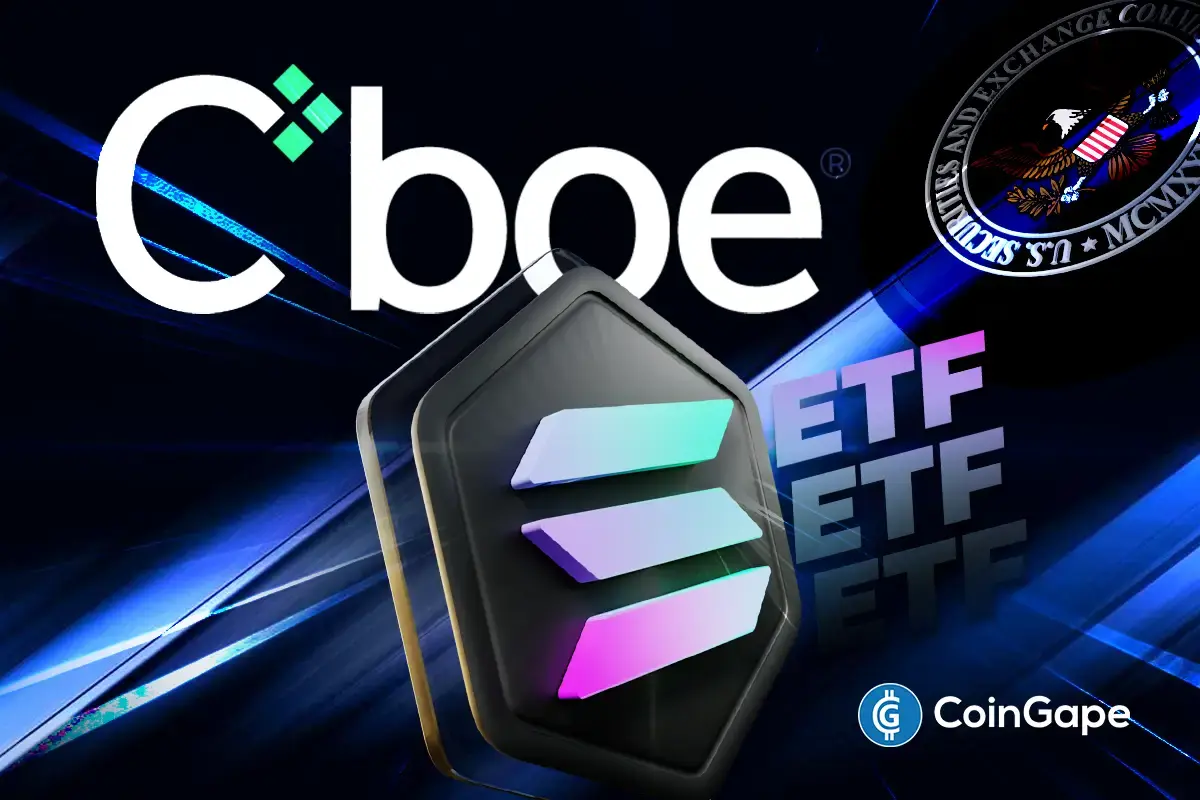Market
Latam Crypto News: Brazil Approves Solana ETF

BeInCrypto comprehensive Latam Crypto Roundup brings Latin America’s most important news and trends. With reporters in Brazil, Mexico, Argentina, and more, we cover the latest updates and insights from the region’s crypto scene.
This week’s roundup includes stories on Solana ETF approval in Brazil, Bolivia’s interest in metal-backed stablecoins, and more.
Brazil Approves World’s First Spot Solana-Based ETF
The Brazilian Securities and Exchange Commission (CVM) has given the green light for the launch of the world’s first spot Solana-based exchange-traded fund (ETF). This product is currently in its pre-operational phase, with final approval pending from Brazil’s main stock exchange, B3.
The spot Solana ETF, managed by QR Asset and operated by Vortx, will track the CME CF Solana Dollar Reference Rate. Theodoro Fleury, Chief Investment Officer of QR Asset, expressed enthusiasm about the new ETF.
“This ETF reaffirms our commitment to offering quality and diversification to Brazilian investors. We are proud to be global pioneers in this segment, consolidating Brazil’s position as a leading market for regulated investments in crypto assets,” Fleury said.
Read more: Solana ETF Explained: What It Is and How It Works
The ETF launch will integrate Solana into mainstream financial systems and mark the first Solana-based product in Brazil. Over the past few years, the Latam country has shown a strong interest in pioneering financial products, with B3 playing a major role.
The exchange has listed several crypto ETFs, including those for Bitcoin and Ethereum, between 2021 and 2022. Most recently, in March 2024, B3 began offering BlackRock’s iShares Bitcoin Trust (IBIT).
Peru Launches New Anti-Money Laundering Regulation for Crypto Companies
Starting August 1, Peru’s cryptocurrency market enters a new regulatory era. The Superintendency of Banking, Insurance, and AFPs (SBS) has introduced the country’s first official framework aimed at preventing money laundering and terrorist financing within the sector.
This regulation requires all cryptocurrency businesses, including digital wallet providers and investment platforms, to follow strict anti-money laundering (AML) measures. The SBS will oversee these entities to ensure they implement a “risk-based approach” to deter illicit activities.
A key aspect of the new rules involves verifying the identity of transaction beneficiaries. This step aims to prevent corrupt funds and other illicit gains from infiltrating the financial system. The regulation covers all transactions, even those under $1,000, with potential for increased scrutiny in the future.
Read more: Crypto Regulation: What Are the Benefits and Drawbacks?
Non-compliance with these regulations could result in severe penalties. Companies that fail to meet the new standards may face hefty fines, the loss of their operating licenses, or the removal of their websites and apps.
This measure aligns with Recommendation 15 of the Financial Action Task Force (FATF), which urges countries to enforce legal frameworks for the supervision of virtual asset service providers (VASPs). Peru’s move follows similar actions in other Latam countries, such as Argentina, where stricter crypto regulations were implemented despite initial resistance.
Paraguay Dismisses Exodus of Miners Despite Higher Electricity Rates
Paraguay’s National Electricity Administration (ANDE) has dismissed concerns over an exodus of cryptocurrency mining companies following a hike in electricity rates. The increase, which raised tariffs by up to 16% for large-scale cryptocurrency miners, sparked fears of companies fleeing to neighboring countries like Brazil.
The Paraguayan Chamber of Mining of Digital Assets (Capamad) had previously warned that many cryptocurrency miners were considering relocating to Brazil due to the rising costs. Capamad suggested that Paraguay could lose its appeal as a favorable location for Bitcoin mining.
However, Félix Sosa, president of ANDE, refuted these claims, asserting that no mining companies had left Paraguay. Sosa highlighted a recent contract with a large mining operation, which secured the supply of 6 megawatts (MW) of electricity, ensuring the continued operation of 72 mining companies in the country.
“A technical evaluation is made to verify where to install, where ANDE has power availability for the installation of this type of load,” Felix Sosa explained to ABC.
Read more: Is Crypto Mining Profitable in 2024?
Sosa also revealed that these 72 companies currently have 391 MW of contracted electricity, with a total potential of 821 MW. He shared that ANDE expects to generate $100 million in revenue from these contracts. Additionally, 400 MW of new contracts with mining companies are pending approval.
In contrast, Jimmy Kim, director of Capamad, noted that the expansion plans of many cryptocurrency mining companies now favor Brazil over Paraguay. He pointed to a contract signed by Penguin Group for 400 MW in Brazil, with another 400 MW in the pipeline.
Despite these tensions, ANDE has maintained its stance, arguing that the increased tariffs will help reduce losses from illegal mining activities, which amount to over $185,000 annually. The tariff increase, outlined in Resolution 49238 issued on June 26, targets large-scale cryptocurrency miners specifically.
Bolivian President Luis Arce is advocating for the adoption of cryptocurrencies backed by metals, such as lithium and gold, as part of a broader strategy to strengthen Bolivia’s financial system. This move aims to integrate digital assets with the country’s abundant mineral resources while reducing reliance on the US dollar.
President Arce highlighted that this initiative would promote the use of metal-backed cryptocurrencies like Tether’s Alloy stablecoin (aUSDT). He noted that the measure is designed to streamline the flow of foreign currency into Bolivia and strengthen the payment system for international transactions.
“The greater dissemination of cryptoassets backed by gold, lithium, and other technological metals like Alloy (aUSDT) will boost the inflow of foreign currency into the country and deepen the payment system for international purchases,” Arce stated.
Read more: A Guide to the Best Stablecoins in 2024

This push follows a recent proposal by Congresswoman Mariela Baldivieso, who introduced a bill in the Bolivian Legislative Assembly to regulate Bitcoin. Baldivieso argued that cryptocurrencies could enable Bolivia to conduct transactions and receive international payments without depending on traditional fiat currencies.
In June, Bolivia lifted its ban on cryptocurrencies, allowing the use of “virtual assets” through Electronic Payment Instruments (EPI). The announcement by Edwin Rojas, president of the Central Bank of Bolivia, marked a shift in the country’s financial policies.
Uruguay Sees Rising Interest in Real Estate Deals Using Bitcoin
Uruguay is witnessing a rising trend in real estate transactions conducted with Bitcoin, signaling a shift in how properties are bought and sold. Recently, a property was purchased for $500,000 in Bitcoin, facilitated by Banque Heritage as an intermediary.
This event is showcasing Bitcoin’s potential as a medium of exchange in real estate. Cryptocurrencies, known for challenging traditional financial systems, offer an alternative to conventional currencies by enabling quick, borderless transfers without the need for banks or other intermediaries.
Local analysts highlight several advantages of using Bitcoin for real estate transactions, including faster processes and reduced costs. By cutting out financial intermediaries, transaction fees decrease, and the global market becomes more accessible, free from the complexities of currency conversions.
Read more: How To Invest in Real-World Crypto Assets (RWA)?
Uruguay has quickly embraced the use of cryptocurrencies in real estate. As of October 1, 2022, a new law allows buying and selling property with digital currencies. This change made what was once considered a swap into a fully legal sale, recognizing cryptocurrencies as valid payment.
The General Tax Directorate, which previously didn’t accept cryptocurrencies for real estate transactions, has now welcomed this new approach. This positions Uruguay as a leader in bringing digital assets into the real estate market. On July 17, 2023, this was clearly demonstrated when a property was sold using Bitcoin, with Banque Heritage and Cryptotrust managing the transaction.
Binance VP for Latam to Speak at RIW 2024 on BeInCrypto Stage
As Rio Innovation Week 2024 approaches, Guilherme Nazar, Vice President for Latin America at Binance, has been confirmed as a speaker on the BeInCrypto stage. Nazar will address the current state of the industry, future prospects, and the path to reaching the next billion users.
Nazar will also discuss the importance of customer focus, education, and security in advancing crypto adoption, particularly in Latam. He noted that Brazil is heavily investing in Web3 solutions, positioning it as a global leader in this area.
“Latin America is a market with great prospects for the digital asset ecosystem, home to three of the top 20 countries in adoption, and there are endless opportunities to develop the local industry, meet users’ needs and educate society. We are determined to work hand in hand with policymakers to define regulations that allow innovation to advance and protect users’ funds,” he said on taking over management of the region.
Read more: A Calendar of the Top Blockchain and Cryptocurrency Events in 2024
Alena Afanaseva, CEO of BeInCrypto, and Fabrício Tota, Director of New Business at Mercado Bitcoin, will join Nazar on stage. Afanaseva has turned BeInCrypto into a global crypto news hub with eight million monthly visitors. Tota, meanwhile, is a key figure in Brazil’s crypto industry.
The BeInCrypto stage at Rio Innovation Week will feature names like Agrotoken, B3, and Comissão de Valores Mobiliários (CVM). Other participants include Itaú Unibanco, Bradesco, BTG Pactual, Banco do Brasil, and Microsoft. TecBan, ABCripto, Bitso, Trexx, MIBR, Plataforma Impact, and the Ethereum Brasil community will also be present.
As the Latam crypto scene grows, these stories highlight the region’s increasing influence in the global market. Stay tuned for more updates and insights in next week’s roundup.
Disclaimer
In adherence to the Trust Project guidelines, BeInCrypto is committed to unbiased, transparent reporting. This news article aims to provide accurate, timely information. However, readers are advised to verify facts independently and consult with a professional before making any decisions based on this content. Please note that our Terms and Conditions, Privacy Policy, and Disclaimers have been updated.
Market
Binance Faces Community Backlash and Boycott Calls


Controversies surrounding token listings, the depegging of the FDUSD stablecoin, and allegations of unethical behavior have raised a crucial question: Is Binance losing its credibility?
These issues threaten to erode trust and challenge Binance’s standing in the crypto industry.
Binance Struggles to Meet the Standard
One of Binance‘s most pressing issues is the poor performance of the tokens listed on the exchange. As BeInCrypto reported earlier, 89% of the tokens listed on the platform in 2025 recorded negative returns.
Even more concerning, another report reveals that most of the tokens listed in 2024 also experienced negative performance.
Listing on Binance was once considered a “launchpad” for new projects. However, it no longer guarantees success.
A prime example is the ACT token, a meme coin listed on the exchange that quickly plummeted. Earlier this week, Wintermute—a major market maker—dumped a large amount of ACT, exerting strong downward pressure on its price and raising concerns about the transparency of Binance’s listing process.
Such criticism has led the community to believe Binance prioritizes listing fees over users’ interests.
Connection to FDUSD
The FDUSD stablecoin has also become a focal point of controversy, with Binance at its center. FDUSD lost its peg, dropping to $0.89 after reports surfaced that its issuing company had gone bankrupt.
Wintermute, one of the largest FDUSD holders outside of Binance, withdrew 31.36 million FDUSD from the exchange at 11:15 AM UTC. This move is believed to have exacerbated the depegging situation, sparking panic in the market.
More concerning, a community member claimed that some Binance employees leaked internal information about the FDUSD incident so they could select whale chat groups.
If true, this would severely damage Binance’s reputation and raise major questions about the platform’s transparency and ethics.
Overall, the community’s dissatisfaction is growing, with many users calling for a boycott of the exchange. Such negative reactions are shaking user confidence in the platform, which was once considered a symbol of credibility in the crypto space.
“Binance today caused massive liquidations on alts listed on their exchange. I warned you all yesterday about their very dirty tactics, specifically GUN. I refuse to use Binance #BoycottBinance,” wrote popular crypto YouTuber Jesus Martinez.
These accusations stem from a central issue that Binance prioritizes profits over user interests. Over the past few months, the community has constantly criticized its listing strategy, arguing that the exchange focuses on “shitcoins” to collect high listing fees without considering project quality.
Although the exchange recently introduced a community voting mechanism to decide on listings, this might not be enough to silence the criticism.
As a Tier-1 exchange, the company is evaluated based on trading volume, security, regulatory compliance, and community trust. However, recent events suggest that the exchange is struggling to maintain these standards.
Disclaimer
In adherence to the Trust Project guidelines, BeInCrypto is committed to unbiased, transparent reporting. This news article aims to provide accurate, timely information. However, readers are advised to verify facts independently and consult with a professional before making any decisions based on this content. Please note that our Terms and Conditions, Privacy Policy, and Disclaimers have been updated.
Market
Stellar (XLM) Falls 5% as Bearish Signals Strengthen

Stellar (XLM) is down more than 5% on Thursday, with its market capitalization dropping to $8 billion. XLM technical indicators are flashing strong bearish signals, suggesting continued downward momentum that could test critical support levels around $0.22.
While a reversal scenario remains possible with resistance targets at $0.27, $0.29, and $0.30, such an upside move would require a substantial shift in market sentiment.
XLM RSI Shows Sellers Are In Control
Stellar’s Relative Strength Index (RSI) has dropped sharply to 38.99, down from 59.54 just two days ago—signaling a notable shift in momentum.
The RSI is a widely used momentum oscillator that measures the speed and magnitude of recent price changes, typically ranging between 0 and 100.
Readings above 70 suggest overbought conditions, while levels below 30 indicate oversold territory. A reading between 30 and 50 often reflects bearish momentum but is not yet extreme enough to trigger an immediate reversal.

With Stellar’s RSI now below the key midpoint of 50 and approaching the oversold threshold, the current reading of 38.99 suggests that sellers are gaining control.
While it’s not yet in oversold territory, it does signal weakening buying pressure and increasing downside risk.
If the RSI continues to fall, XLM could face further price declines unless buyers step in soon to stabilize the trend and prevent a slide into more deeply oversold levels.
Stellar CMF Heavily Dropped Since April 1
Stellar’s Chaikin Money Flow (CMF) has plunged to -10, a sharp decline from 0.19 just two days ago, signaling a significant shift in capital flow dynamics.
The CMF is an indicator that measures the volume-weighted average of accumulation and distribution over a set period—essentially tracking whether money is flowing into or out of an asset.
Positive values suggest buying pressure and accumulation, while negative values point to selling pressure and capital outflow.

With XLM’s CMF now deep in negative territory at -10, it indicates that sellers are firmly in control and substantial capital is leaving the asset.
This level of negative flow can put downward pressure on price, especially if it aligns with other bearish technical signals. Unless buying volume returns to offset this outflow, XLM could continue to weaken in the near term.
Will Stellar Fall To Five-Month Lows?
Stellar price action presents concerning signals as EMA indicators point to a strong bearish trend with significant downside potential.
Technical analysis suggests this downward momentum could push XLM to test critical support around $0.22. It could breach this level and fall below the psychologically important $0.20 threshold—a price not seen since November 2024.
This technical deterioration warrants caution from traders and investors as selling pressure appears to be intensifying.
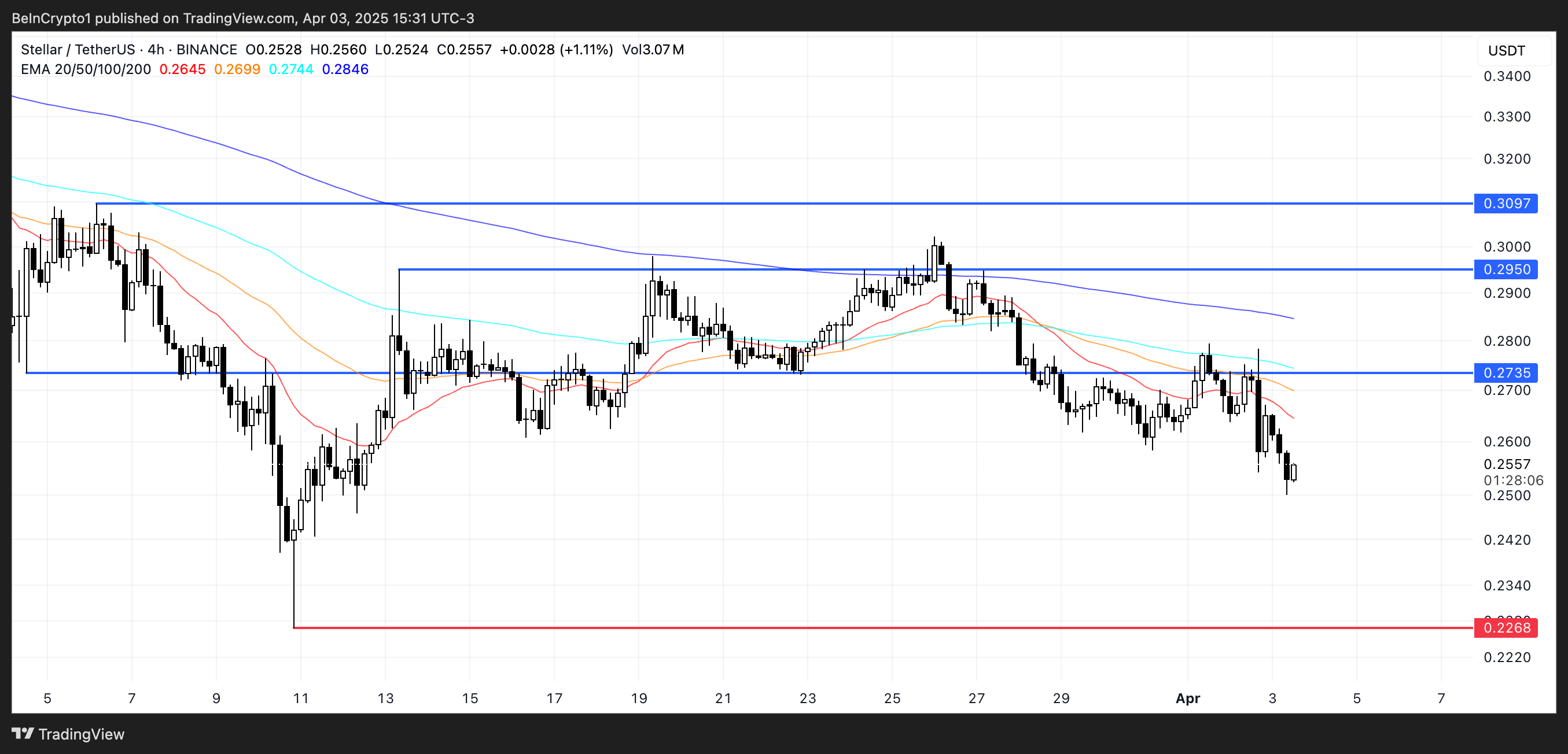
Conversely, a trend reversal scenario would require a substantial shift in market sentiment. Should bulls regain control, XLM could challenge the immediate resistance at $0.27, with further upside targets at $0.29 and the key $0.30 level.
However, this optimistic outlook faces considerable obstacles, as only a dramatic sentiment shift coupled with the emergence of a powerful uptrend would enable such a recovery.
Until clearer bullish signals manifest, the prevailing technical structure continues to favor the bearish case.
Disclaimer
In line with the Trust Project guidelines, this price analysis article is for informational purposes only and should not be considered financial or investment advice. BeInCrypto is committed to accurate, unbiased reporting, but market conditions are subject to change without notice. Always conduct your own research and consult with a professional before making any financial decisions. Please note that our Terms and Conditions, Privacy Policy, and Disclaimers have been updated.
Market
Solana (SOL) Crashes 11%—Is More Pain Ahead?

Solana (SOL) is under heavy pressure, with its price down more than 10% in the last 24 hours as bearish momentum intensifies across key indicators. The Ichimoku Cloud, BBTrend, and price structure all point to continued downside risk, with SOL now hovering dangerously close to critical support levels.
Technical signals show sellers firmly in control, while the widening gap from resistance zones makes a near-term recovery increasingly difficult.
Solana’s Ichimoku Cloud chart is currently flashing strong bearish signals. The price has sharply broken below both the Tenkan-sen (blue line) and Kijun-sen (red line), confirming a clear rejection of short-term support levels.
Both of these lines are now angled downward, reinforcing the view that bearish momentum is gaining strength.
The sharp distance between the latest candles and the cloud further suggests that any recovery would face significant resistance ahead.
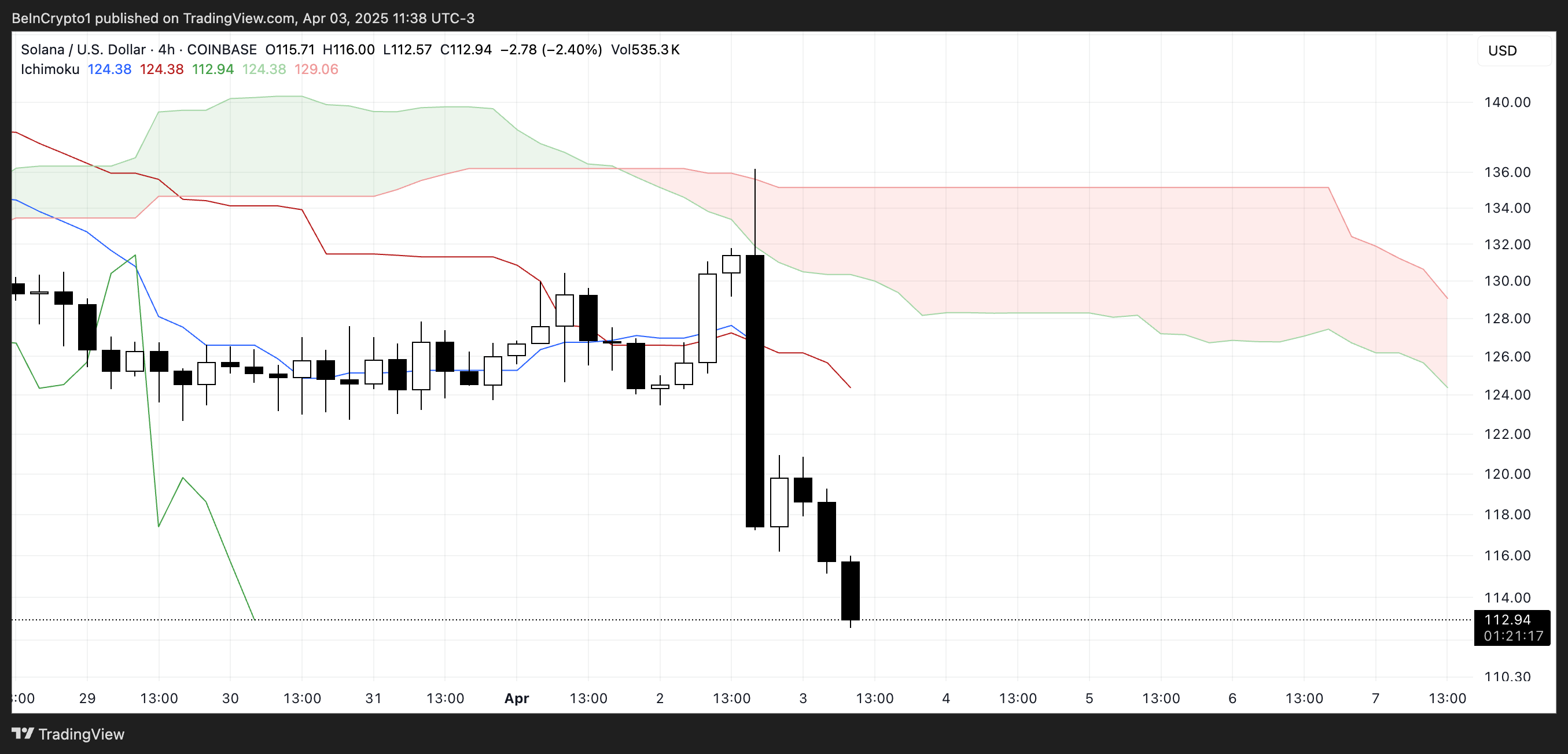
Looking at the Kumo (cloud) itself, the red cloud projected forward is thick and sloping downward, indicating that bearish pressure is expected to persist in the coming sessions.
The price is well below the cloud, which typically means the asset is in a strong downtrend.
For Solana to reverse this trend, it would need to reclaim the Tenkan-sen and Kijun-sen and push decisively through the entire cloud structure—an outcome that looks unlikely in the short term, given the current momentum and cloud formation.
Solana’s BBTrend Signals Prolonged Bearish Momentum
Solana’s BBTrend indicator currently sits at -6, having remained in negative territory for over five consecutive days. Just two days ago, it hit a bearish peak of -12.72, showing the strength of the recent downtrend.
Although it has slightly recovered from that low, the sustained negative reading signals that selling pressure remains firmly in control and that the bearish momentum hasn’t yet been reversed.
The BBTrend (Bollinger Band Trend) measures the strength and direction of a trend using Bollinger Bands. Positive values suggest bullish conditions and upward momentum, while negative values indicate bearish trends.

Generally, values beyond 5 are considered strong trend signals. With Solana’s BBTrend still well below -5, it implies that downside risk remains elevated.
Unless a sharp shift in momentum occurs, this persistent bearish reading may continue to weigh on SOL’s price in the near term.
Solana Eyes $112 Support as Bears Test February Lows
Solana’s price has broken below the key $115 level, and the next major support lies around $112. A confirmed move below this threshold could trigger further downside. That could potentially push the price under $110 for the first time since February 2024.
The recent momentum and strong bearish indicators suggest sellers remain in control, increasing the likelihood of testing these lower support levels in the near term.
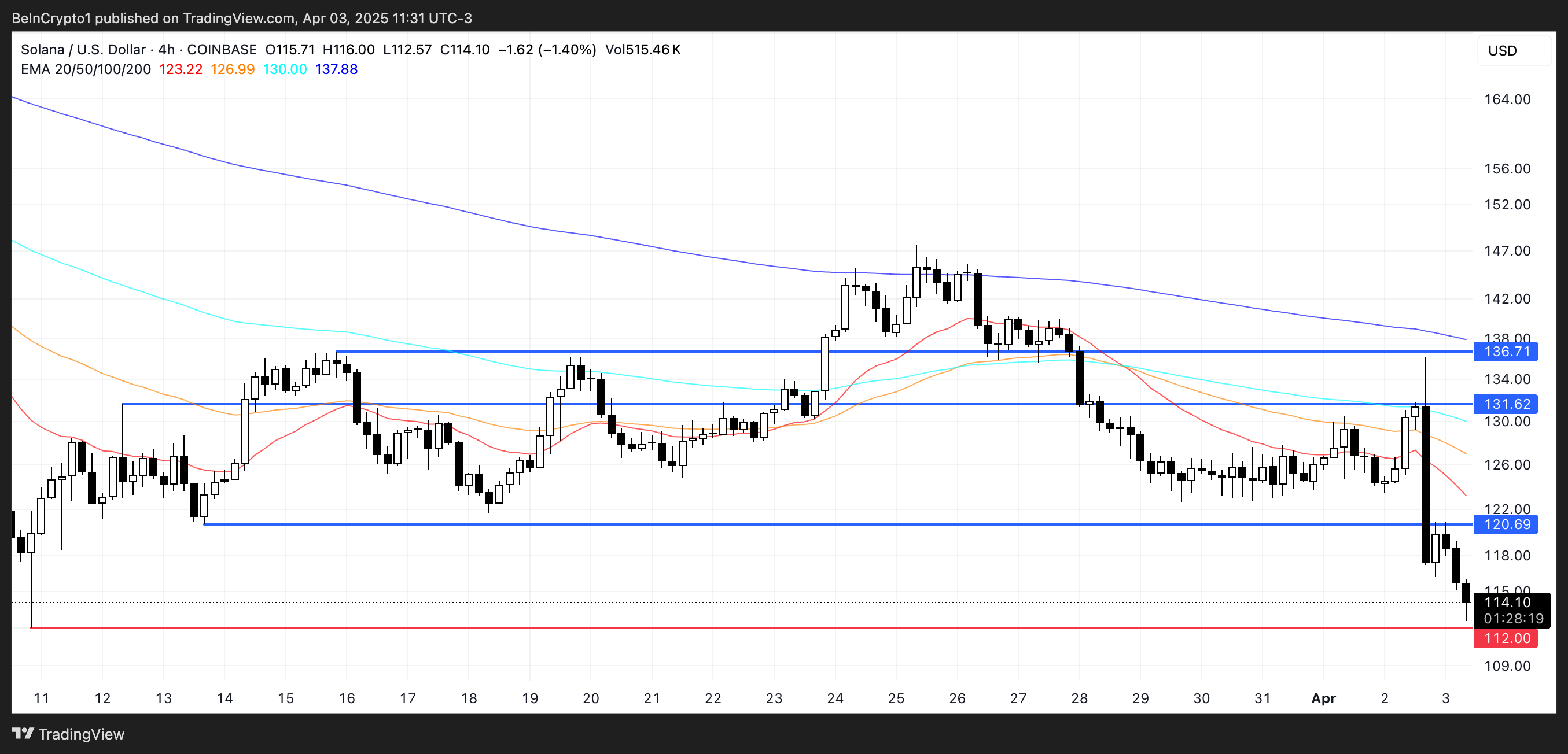
However, if Solana manages to stabilize and reverse its current trajectory, a rebound toward the $120 resistance level could follow.
Breaking above that would be the first sign of recovery, and if bullish momentum accelerates, SOL price could aim for higher targets at $131 and $136.
Disclaimer
In line with the Trust Project guidelines, this price analysis article is for informational purposes only and should not be considered financial or investment advice. BeInCrypto is committed to accurate, unbiased reporting, but market conditions are subject to change without notice. Always conduct your own research and consult with a professional before making any financial decisions. Please note that our Terms and Conditions, Privacy Policy, and Disclaimers have been updated.
-

 Altcoin21 hours ago
Altcoin21 hours agoAnalyst Forecasts 250% Dogecoin Price Rally If This Level Holds
-

 Market20 hours ago
Market20 hours agoCardano (ADA) Downtrend Deepens—Is a Rebound Possible?
-

 Market19 hours ago
Market19 hours agoEthereum Price Recovery Stalls—Bears Keep Price Below $2K
-

 Market21 hours ago
Market21 hours agoXRP Price Under Pressure—New Lows Signal More Trouble Ahead
-

 Market16 hours ago
Market16 hours agoIP Token Price Surges, but Weak Demand Hints at Reversal
-

 Bitcoin18 hours ago
Bitcoin18 hours agoUS Dollar Index Drops – What Does It Mean for Bitcoin?
-

 Market15 hours ago
Market15 hours agoHBAR Foundation Eyes TikTok, Price Rally To $0.20 Possible
-
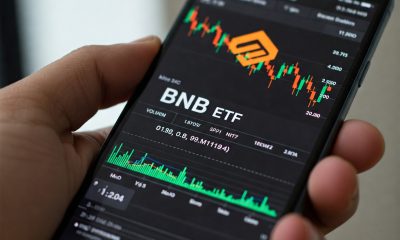
 Altcoin18 hours ago
Altcoin18 hours agoVanEck Seeks BNB ETF Approval—Big Win For Binance?


